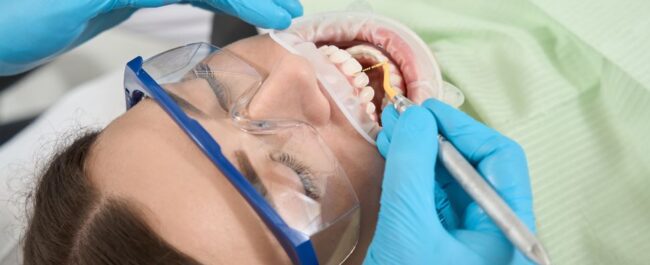How to Get Rid of Plaque – and Help Prevent it Naturally!
Plaque Removal During a Dental Visit
If you’re like most people, a visit to the dentist involves plaque removal as part of your cleaning. Plaque removal can be performed by a dental hygienist or dentist. The most common method is to use a tool called a scaler or a dental scraper.
The scaler is a small, hooked instrument that allows the dentist to scrape the plaque and tartar from the surface of the teeth and along the gum line. Tartar is what plaque turns into as it hardens. The scaler removes the hardened deposits that cannot be removed by brushing or flossing alone. In some cases, an ultrasonic scaler that uses vibrations to break up the plaque and tartar.
In more extreme cases, the dentist may recommend a deep cleaning procedure called scaling and root planing. This is typically done when there is significant build-up of plaque and tartar below the gum line, which can cause gum disease.
It’s clear, regular dental visits are a must for maintaining optimal oral health. But what can you do at home?
At Reflections-Dental in Oakville, we love offering great tips and advice to our patients and the larger community. If you’re new to Oakville and looking for dental care for your family, contact us!
Avoid Extreme Cases – Focus on Plaque Prevention!
Plaque, a sticky film of bacteria on teeth, can lead to tooth decay and gum diseases – if you let it. Prevention is the key! Fortunately, there are several ways to prevent plaque build-up and remove it naturally. Here are 9 ways to get fighting!
- Brush and floss regularly
The most effective way to prevent plaque build-up is to brush and floss regularly. Brushing twice a day and flossing once a day will remove plaque from the teeth and gums. When brushing, it is important to use a fluoride toothpaste and to brush for at least two minutes. Make sure to brush all surfaces of the teeth, including the fronts, backs, and tops.
When flossing, be gentle and careful not to damage the gums. Flossing will remove plaque and food particles from between the teeth that cannot be reached by brushing alone. Regular brushing and flossing will help prevent the build-up of plaque and keep your teeth and gums healthy.
- Use an antiseptic mouthwash
In addition to brushing and flossing, using an antiseptic mouthwash can help prevent plaque build-up. Mouthwash contains antiseptic agents that kill bacteria in the mouth, reducing the amount of plaque that can form. It is important to use mouthwash after brushing and flossing, as it will help to remove any remaining bacteria in the mouth.
- Eat a healthy diet
A healthy diet can also help prevent plaque build-up. Avoid sugary and acidic foods and drinks, as they can contribute to the formation of plaque. Instead, eat a diet rich in fruits and vegetables, whole grains, lean protein, and dairy products. These foods are rich in vitamins and minerals that promote healthy teeth and gums.
- Drink plenty of water
Drinking plenty of water can also help prevent plaque build-up. Water helps to rinse away food particles and bacteria in the mouth, reducing the amount of plaque that can form. It is recommended to drink at least 8 glasses of water a day for optimal dental health.
- Chew sugar-free gum
Chewing sugar-free gum after meals can also help prevent plaque build-up. Gum stimulates the production of saliva, which helps to rinse away food particles and bacteria in the mouth. It is important to choose sugar-free gum, as sugary gum can contribute to the formation of plaque.
- Oil pulling
Oil pulling is an ancient Ayurvedic practice that involves swishing oil in the mouth for several minutes to remove toxins and bacteria. Coconut oil is commonly used for oil pulling, as it has antimicrobial properties that can help remove plaque and promote healthy gums. To oil pull, simply swish a tablespoon of coconut oil in the mouth for 10-15 minutes, then spit it out and rinse with water.
- Baking soda
Baking soda is a natural abrasive that can help remove plaque from the teeth. Mix a small amount of baking soda with water to create a paste, then brush the teeth with the paste for 2-3 minutes. Baking soda can be abrasive, so it is important to use it sparingly and not to brush too hard.
- Apple cider vinegar
Apple cider vinegar is another natural remedy that can help remove plaque from the teeth. Mix a small amount of apple cider vinegar with water and use it as a mouthwash after brushing and flossing. Apple cider vinegar has antimicrobial properties that can help kill bacteria in the mouth and prevent plaque build-up.
- Eat crunchy fruits and vegetables
Eating crunchy fruits and vegetables can also help remove plaque from the teeth. Apples, carrots, and celery are particularly effective at removing plaque, as they require a lot of chewing
Visit Your Dentist & Practice Plaque Fighting Habits
Overall, regular dental visits are crucial in preventing plaque build-up and maintaining good dental health. A dentist can remove plaque effectively and help prevent more serious dental issues from developing. In addition to professional dental cleanings, it is important to practice good oral hygiene habits at home, such as brushing twice a day, flossing daily, and using an antiseptic mouthwash.


